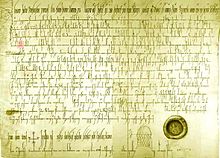Royal Court and Calbe Castle
| Calbe Castle | ||
|---|---|---|
| Alternative name (s): | Sudenburg | |
| Conservation status: | Ground monument | |
| Place: | Calbe (Saale) | |
| Geographical location | 51 ° 54 '8.2 " N , 11 ° 46' 28.6" E | |
|
|
||
In 965 the royal court (Curtis regia) Calbe was mentioned as such when, at the Easter celebration in the Pfalz Ingelheim, Emperor Otto I, on the recommendation of his son, Archbishop Wilhelm of Mainz , presented Calber Curtis together with the royal court of Rosenburg to St. -Mauritius-Stift in Magdeburg . As early as 961, this facility was called the " Burgwardium " when Otto I gave the tithes of the German and Slavic residents belonging to the Burg district to the Magdeburg Moritz monastery on April 23rd in Wallhausen near Sangerhausen .
Possible time of origin
It can be assumed that the beginnings of the Calvian royal court already existed in Carolingian times, as it was located directly on an old salt , amber and military road close to the Saale . The Carolingian Heerstrasse ran through what is now Calbe from Magdeburg to Halle ( Giebichenstein ). Around 810, in the last decade of his reign, Charlemagne held an army show in nearby Starasvorde an der Bode ( Staßfurt ) .
So far there are no archaeological findings from the "Curtis regia" Calbe.
location
The "Curtis regia" was located in the area of today's city center south of St. Stephen's Church between today's streets: Kuhgasse, Bernburger and Ritterstraße.
Using city files, K. Herrfurth proved convincingly that the baptistery of the royal court was the “ St. Johannis Baptistae ” chapel , the remains of which can still be seen on the corner of Kuhgasse and Ritterstrasse.
Since John the Baptist was venerated in a special way by Otto's father, Heinrich I , and under King Heinrich the establishment of the Burgward system along the Elbe - Saale line, the Calber royal court (see above) must have been built at least initially of the 10th century.
Continued existence as an archbishop's seat
When in 967 and 968, at the suggestion and request of Otto I in Ravenna, the Moritzstift Magdeburg was elevated to the status of an archbishopric, the Calber Curtis also fell to the Magdeburg archbishops, who increasingly viewed them as a second and summer residence. In the period that followed, the sources kept referring to Calbe Castle (civitas, urbs) and Burgvorstadt (suburbium, later: Bernburger Vorstadt). The Calbian castle was built of wood in the 10th century, according to a report by the Jewish trader and scholar Ibrahim Ibn Jacub from around 970 .
In 1489 the southern city gate was still called the “ castle gate”, and the tower on the already partially demolished southern city wall was still called the “ castle tower” in 1745 .
The End
The existence of the Calber Archbishop's Court is documented until the 13th century. Then the centuries-old complex no longer met the sovereign demands, and in the 14th century the castle fortress was built in the northeast of the city. The decaying buildings of the royal court in Calbe were demolished and the complex was included in the extensive urban expansion under Archbishop Dietrich von Portitz (see Breite (Calbe) ). The manor was a relic and a financial successor to the old Curtis.
swell
- Widukind's Saxon Stories / Translated by Reinhold Schottin from the edition of the Monumenta Germaniae. In addition to the writing on the origin of the Swabians and Abraham Jakobsen's report on the Slavic countries, Leipzig 1891.
- Otto I. 961. Reg. 25. Ind. 4., in: Regesta Imperii, II, 1 Heinrich I. and Otto I. 919-973, ed. v. Emil von Ottenthal, Innsbruck 1893, p. 143.
- Otto I. 965. Reg. 29. Imp. 4 Ind. 8., in: Regesta Imperii, II, 1 Heinrich I. and Otto I. 919-973, ed. v. Emil von Ottenthal, Innsbruck 1893, p. 178.
- Otto I. 967. Reg. 32. Imp. 6 Ind. 10., in: Regesta Imperii, II, 1 Heinrich I. and Otto I. 919-973, ed. v. Emil von Ottenthal, Innsbruck 1893, p. 201.
- Otto I. 968. Reg. 33. Imp. 7 Ind. 12., in: Regesta Imperii, II, 1 Heinrich I. and Otto I. 919-973, ed. v. Emil von Ottenthal, Innsbruck 1893, p. 214.
- Adolf Reccius: Chronicle of the homeland (documentary news ...). Calbe / Saale 1936.
literature
- Max Dietrich: Calbens resting places. (Calbe) 1894.
- Johann Heinrich Hävecker: Chronica and description of the cities Calbe, Acken and Wantzleben ... Halberstadt 1720.
- Klaus Herrfurth: royal court and merchant settlement of the city of Calbe on the Saale. In: Castles and palaces in Saxony-Anhalt (reports from the Saxony-Anhalt regional group of the German Castle Association). Issue 12.
- Dieter Horst Steinmetz: Evidence: Königshof already around 800. In: Schönebecker Volksstimme from September 28, 2006.
- Dieter Horst Steinmetz: Where was the castle of Calbe once? In: Schönebecker Volksstimme from January 25, 2007.
- Dieter Horst Steinmetz: From the royal court of Caluo in 936 to the district town of Calbe in 1919 - history of a central German town from the beginnings to the foundation of the Weimar Republic. Magdeburg / Calbe / S. 2010, p. 16f.



